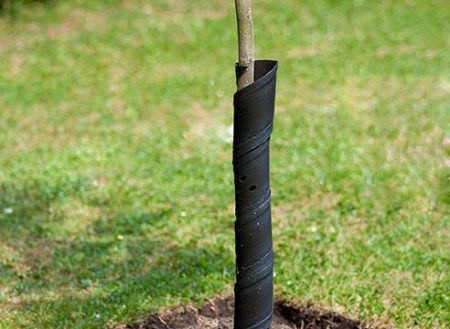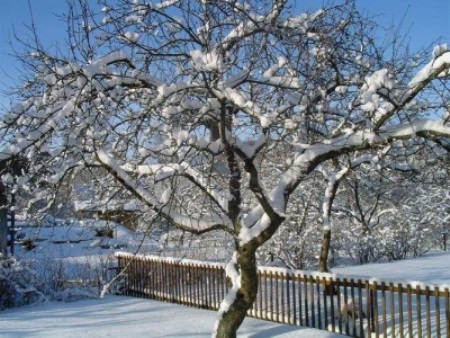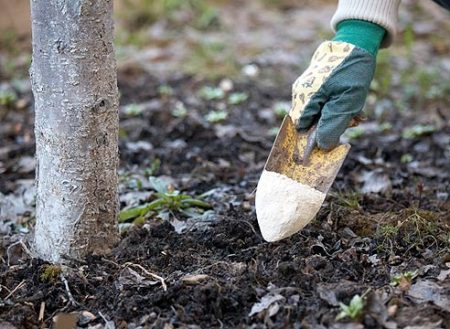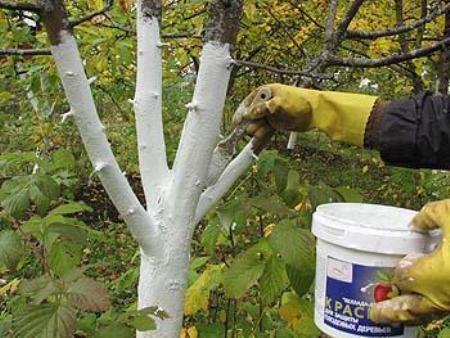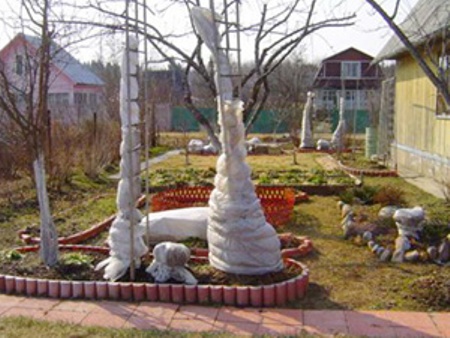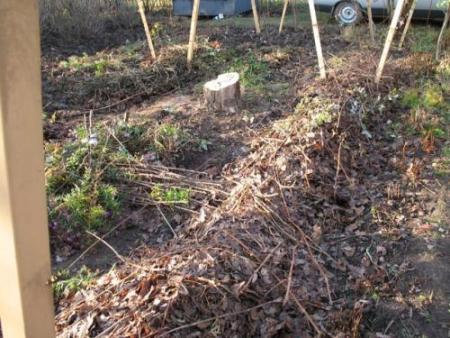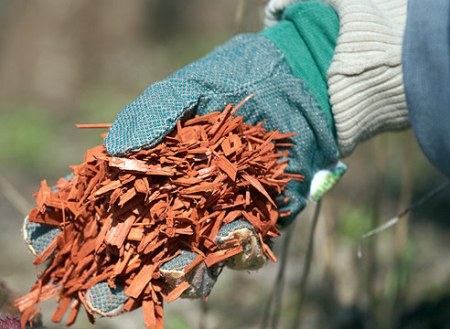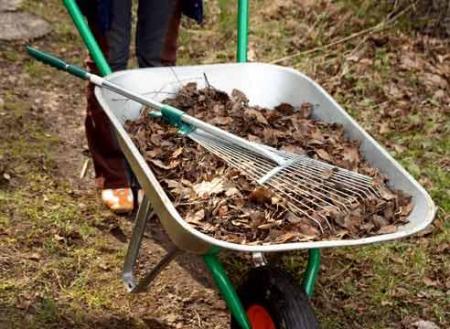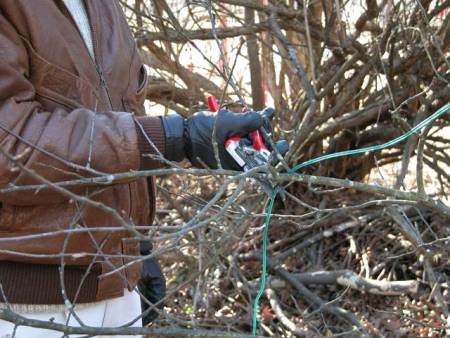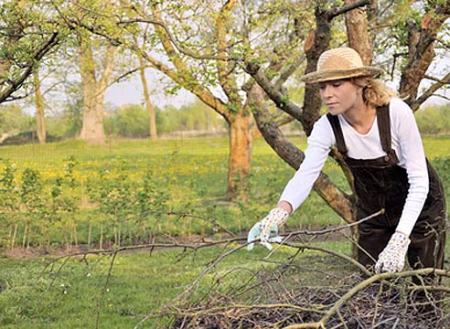With the arrival of the last summer days or the later autumn period (all depends on the climatic conditions of residence), gardeners embark on one of the most important and global works - preparing fruit and berry bushes and trees for wintering. The winter period for almost all perennial plants is the most difficult time of their life. Unfavorable weather in the summer, from the force will deprive the owners of the harvest, and a severe winter can lead to the death of all and shrubs and trees.
Content
What dangers threaten the garden in winter
From the above we can conclude: the main task of gardeners is to create conditions that maximize the safety of garden plantations in the winter season, in other words, to provide protection from winter unfavorable weather conditions. In winter, after a low temperature threatening trees full freezing, not a small harm can cause and sun rays, which leave on the bark traces in the form of sunburn.
After this, there may be embodiments of cracks of different depths on trees and shrubs trunks that are provoked strong and durable frost and death of the young shoots of strong wind at a low temperature, the deformation of branches under the weight of the snow mass, contend, rotting, bulging and wetting root part of plants.
Winter is a difficult time not only for representatives of the flora, but also for the fauna. Therefore, one should also worry about protection from rodents: mice, rats, rabbits and the like. All gardeners, both amateurs and professionals, are obliged to make every effort and try to ensure 100% safety of garden plantations, that is, to save their lives.
Features of wintering of different varieties of fruit trees
The volume and variety of damage caused by plants in winter depends on their general health, age, care at other times of the year, and on the specific characteristics of the fruit and berry crops inherent in each variety and species.
For example, there is almost every garden, a tree like an apple tree. Characterized on the positive side of its ability to adapt to the different climatic conditions inherent in a certain area, as well as endurance and stamina. Most types of apple varieties are almost painlessly tolerated by thirty degrees below zero. Trees of this kind have the ability to independently repair the damage.
With pears, the matter is much more serious. Their percentage of winter hardiness is much lower. Damage, which can lead these plants to death, can appear already at minus twenty. Approximately the same percentage of winter hardiness plum and cherry representatives of fruit and berry crops have.
It is worth noting another important and important point - almost all fruit bearing trees have a huge risk of getting winter damage if their landings were made to the soil not drained, that is, soil containing excess moisture. It is quite easy to avoid this problem: it is enough to perform drainage works in the place designated for planting fruit trees in advance.
Garden in autumn - what measures should be taken in preparation for wintering
With regard to fertilizers required for plants in winter, gardeners need to know the following:
- all trees in winter, regardless of the temperature of the environment, continuously flowing certain phases of life
- by the end of autumn, a certain amount of nutrients is accumulated in the trunk and root system, with which the tree feeds all winter time and which contributes to the awakening of the plant in the spring
- the presence in the soil of a sufficient number of phosphorus and potassium fertilizers helps to increase the percentage of winter hardiness, gives a positive dynamics in the growth of plants
- the correct application of fertilizers (meaning the amount and time) will inevitably entail not being exposed to the influence of low temperatures, by accumulating in the plants a sufficient amount of potassium, calcium and phosphorus.
In addition to all of the above, gardeners need to remember that:
- trees having a tight, impermeable crown, have a greater risk of getting damage from frost than, for example, with a thinned
- young trees will be injured less than adults of the same variety, and while still receiving any injuries, recovery will occur faster and with less effort
- weakened trees, seedlings and shrubs, as well as damaged by some diseases, experience low temperatures much worse than healthy ones
- the trees from which they harvested a large crop in the past season are much more likely to suffer in the winter than the trees on which the harvest was not at all.
How to prepare a garden for winter
To prevent the harmful effects of natural factors on the state of the branches and bark of plants, they must be whitewashed with a calcareous composition. Such events are held in late autumn, after the rainy season ends. For example, you can perform whitewashing during autumn works in the garden in October. Temporary winter thaw can wash away the protective layer of lime. In order to keep it you need to use a strapping.
To make the strapping, the following materials will be required: raspberry, tulle, spruce or pine paws, cane, ruberoid, cane shoots, fiberglass, nylon stockings.
Experts advise not to use materials on a fabric basis for strapping, because both rags and burlap are wet with the temporary thaw and they will create excellent conditions for the formation of rot and mold. In addition, it makes no sense to use polyethylene materials, since on a sunny winter day they will create a greenhouse effect, which also does not have a favorable effect on the general condition of the plant and on its bark.
A tie made of straw or dry grass also will not give the desired result unless its design is properly made. These materials will necessarily attract the attention of hungry rodents. Therefore, the lower part of the strapping is deepened into the soil. This option will help protect the plant from penetration and damage to rodents. The height of the strapping should exceed the level of the snow mass and at the same time serve as a protection for the lower branches from the family of hare. Installation of protection of this kind is made as close as possible to the trunk. The ideal time to mount the strapping is the end of October.
Autumn work in the garden - protection of the root system
Protection of the root system reduces to mulching the soil around the tree. This procedure will protect not only the root in severe frost, but will save the life of the whole plant. Mulching is performed in the upper soil layers with compost, foliage, sawdust, manure, humus, peat.
Care of the garden
Any gardener planning to plant a fruit garden wants to grow healthy and strong trees that would please their good and big harvest. For this, the branches of plants must be strong, and also adapted for the harvesting process. Such a state of branches can be achieved by trimming branches, which is held every year in the spring. Pruning is a wound and depends on the condition of the plant and its age.
Pruning for sanitary purposes. No matter how carefully the trees are taken care of, the dried and broken branches will appear on them in any case. They must necessarily be removed from a healthy part of the plant.
Support pruning. This type of trimming reduces to thinning the crown. Fruit trees grow both horizontally and vertically. Decimation must be made in time and correctly. Particular attention should be paid to the branches growing vertically, because the fruits ripened on them can be in a hard-to-reach zone and the abyss. To completely limit growth, it is sufficient to eliminate part of the branch located in the center.
Pruning of this kind will lead to an improvement in the state of the deciduous cover and will contribute to the formation of larger fruits.
The thinning process is also important for proper growth and development of plants. special attention should be paid to branches located at a sufficiently close distance from each other or those that are aimed at crossing. They must either be cut off, or (if there is such an opportunity) to disconnect. The pruning of fruit and berry trees, produced during the summer period, is usually aimed at shaping the crown, which in turn gives sufficient access to the sun rays to the fruits that begin to ripen.
Rejuvenating pruning. This variant of rejuvenation is applied to trees in which fruits begin to diminish in size, the growth and development of branches stops or significantly slows down, fruits form only on the edges of branches, in other words, to trees that begin to age. If you find all of the above signs, the gardener should understand that the root system has stopped in full force to feed the vast crown with the necessary components and moisture. Rejuvenating pruning will significantly improve and significantly prolong the fruiting time.
With such pruning, first of all, the number of branches is significantly reduced. Then cut branches growing more than three years. Thus, in the final of the work there are only young branches located near the trunk. Experts with full confidence assert that such procedure will prolong a life of a plant which will please owners with succulent and big fruits.
Qualitatively caring for the garden all year round, and especially, properly preparing it for wintering, gardeners will get a great pleasure from harvesting a rich harvest.



